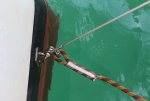Goldie
Well-known member
My current anchoring set-up is resulting in an issue I've never experienced before. I attach the snubber to the chain with a chain hook, pay out the chain until there's a reasonable bight and the snubber has the load on a cleat, and then go astern to set the anchor (so no load on the chain or windlass). When the load comes on the snubber, the chain hook and chain rotate several turns and whilst they turn most of the way back when the load comes off, I'm often left with a bit of a 'ball' which needs to be unwrapped by hand when the chain is recovered and before the chain hook can be removed - a bit of a finger hazard if there is any sea running. I've never experienced this on previous boats, so what is different? The snubbing line is 3 strand nylon, the chain 10mm and the gypsy is on a capstan (i.e. vertical axis as opposed to horizontal axis windlass). The latter is the only difference I can think of from previous boats, all of which had a windlass. Is this a factor? Does this induce some twist in the chain? Is there some sort of torque effect from the three strand? Constructive suggestions would be gratefully received.
Thank you.
Thank you.

